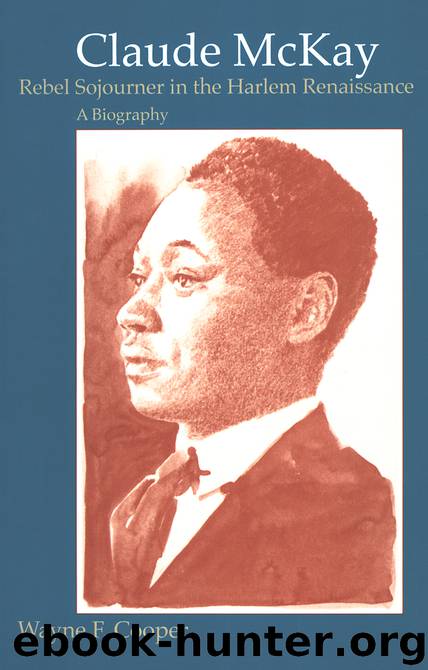Claude McKay, Rebel Sojourner in the Harlem Renaissance by Wayne F. Cooper;

Author:Wayne F. Cooper;
Language: eng
Format: epub
Publisher: Lightning Source Inc. (Tier 1)
Published: 1987-03-11T16:00:00+00:00
9
The Expatriate Years, 1929–1934: Gingertown and Banana Bottom
Despite his underlying reservations, McKay had some good times in Paris with the cast of Blackbirds, with Countee Cullen, and with a pretty, young black socialite named Anita Thompson, who would eventually follow him to Tangier. During the latter part of his stay in Paris, however, he became nervous, irritable, and depressed. In A Long Way from Home, he maintained that Paris had always had this effect upon him. He could never work there; the city distracted him. In addition, his health was not good.1
All this may have been true, but there was yet another reason for McKay’s unhappiness. To his dismay, he learned that his long-lost wife, residing again in New York, was seeking to “tie up” his royalties in a legal knot that would bind him once again to support her and their child, whom he had never seen. While not averse to aiding his daughter, he wished to do it on his own terms. To forestall legal proceedings, he invited his wife to visit him in Paris. When she arrived, they discussed their situation, and McKay somehow succeeded in averting a costly legal battle. But the emotional price to both was great. His wife left with the accumulated bitterness of many years, intensified by the realization that what little he could give her would not be worth a court fight to get. Even the money he advanced for their daughter Hope’s support and education went to McKay’s relatives in Jamaica. While her mother worked in New York City, Hope remained in Jamaica. Claude’s family saw to it that Hope received a good education, and her maternal family, the Lewars, gave her the warmth and emotional support to overcome the bewildering sense of abandonment she sometimes felt in the absence of both her parents.2
McKay’s traumatic confrontation with his wife left him nervous, distraught, and depressed. He began to drink again, which did not help. One night his old friend Louise Bryant Bullitt found him drunk and depressed in a cafe. She urged him to leave Paris and to go back to work. McKay heeded the advice. Louise’s own deplorable condition probably served as warning enough. Since McKay had last seen her in 1925, Louise had lost her health, her beauty, and her husband and child. McKay was appalled by her decline. Besides drinking too much, she consorted with an unpleasant woman whom McKay detested. Still, Louise remained a friend, and he saw her often during his stay in Paris.3
Late in July he went to Antwerp for a brief vacation, but he returned to Paris, where he lingered until late August. Max Eastman had written earlier from the United States that he planned to arrive in August, and McKay wanted to see him. In the interval, he tried without success to write. The social distractions of Paris combined with chronic health problems—headaches, “sciatica” (in his arm and shoulders), and high blood pressure—defeated again his best efforts to concentrate.
In desperation, he went with a young medical student to Bilbao and then to San Sebastian in northeastern Spain.
Download
This site does not store any files on its server. We only index and link to content provided by other sites. Please contact the content providers to delete copyright contents if any and email us, we'll remove relevant links or contents immediately.
| African | Asian |
| Australian & Oceanian | Canadian |
| Caribbean & Latin American | European |
| Jewish | Middle Eastern |
| Russian | United States |
4 3 2 1: A Novel by Paul Auster(11800)
The handmaid's tale by Margaret Atwood(7459)
Giovanni's Room by James Baldwin(6818)
Big Magic: Creative Living Beyond Fear by Elizabeth Gilbert(5360)
Asking the Right Questions: A Guide to Critical Thinking by M. Neil Browne & Stuart M. Keeley(5360)
Ego Is the Enemy by Ryan Holiday(4963)
On Writing A Memoir of the Craft by Stephen King(4668)
The Body: A Guide for Occupants by Bill Bryson(4590)
Ken Follett - World without end by Ken Follett(4449)
Bluets by Maggie Nelson(4268)
Adulting by Kelly Williams Brown(4239)
Eat That Frog! by Brian Tracy(4163)
Guilty Pleasures by Laurell K Hamilton(4124)
White Noise - A Novel by Don DeLillo(3834)
The Poetry of Pablo Neruda by Pablo Neruda(3821)
Fingerprints of the Gods by Graham Hancock(3742)
Alive: The Story of the Andes Survivors by Piers Paul Read(3737)
The Book of Joy by Dalai Lama(3704)
The Bookshop by Penelope Fitzgerald(3622)
